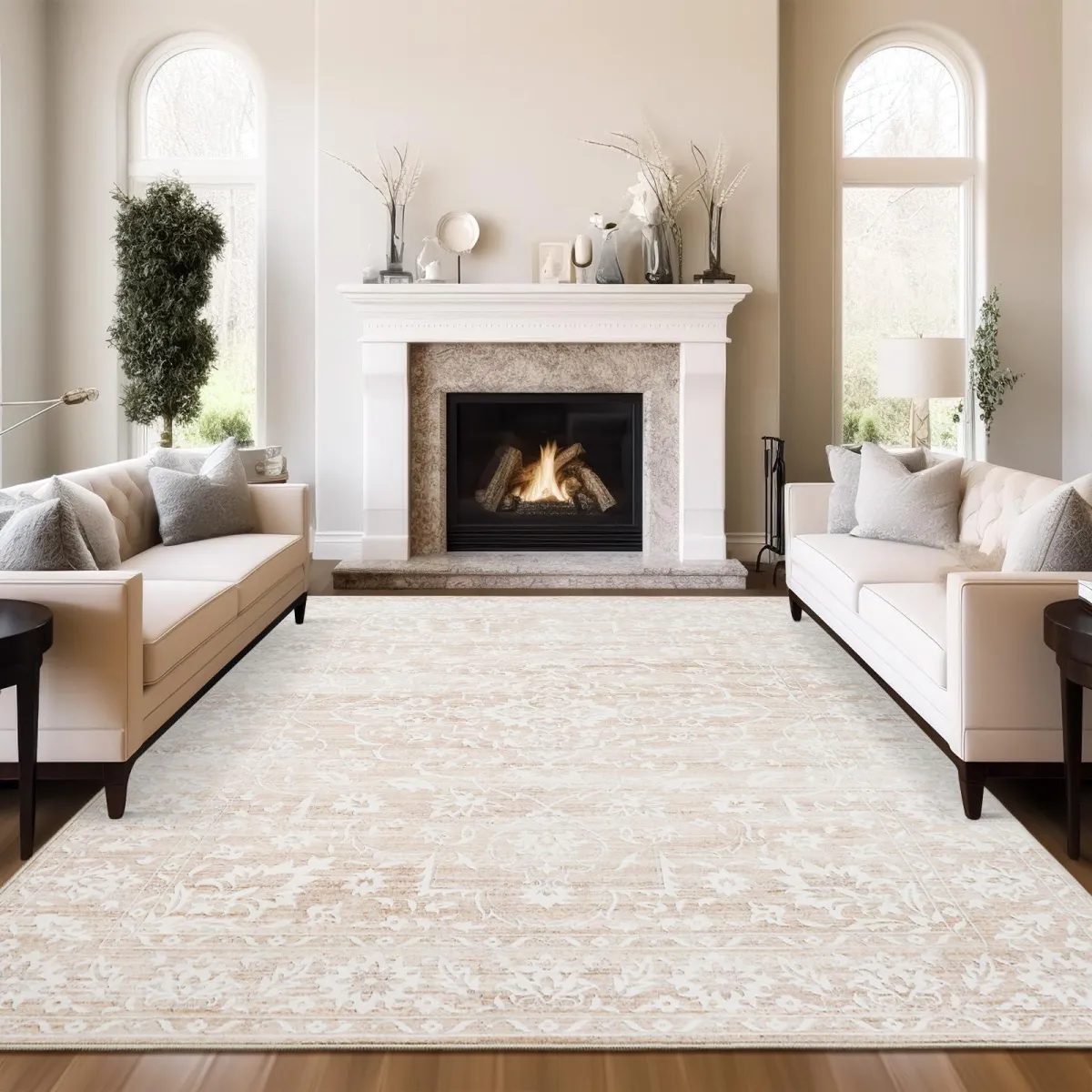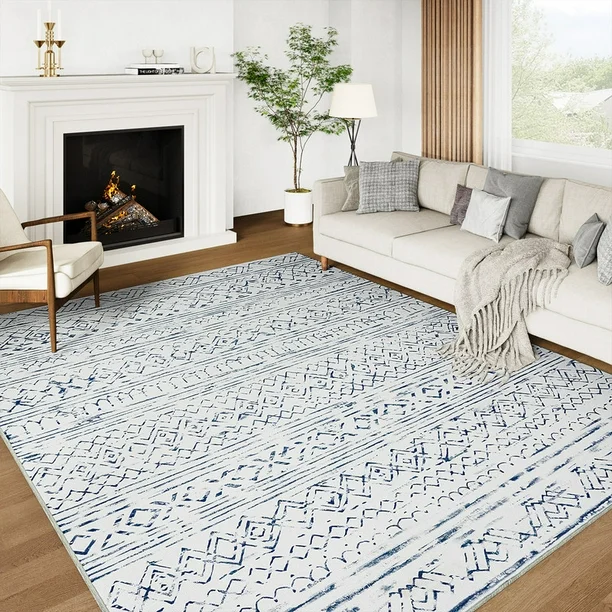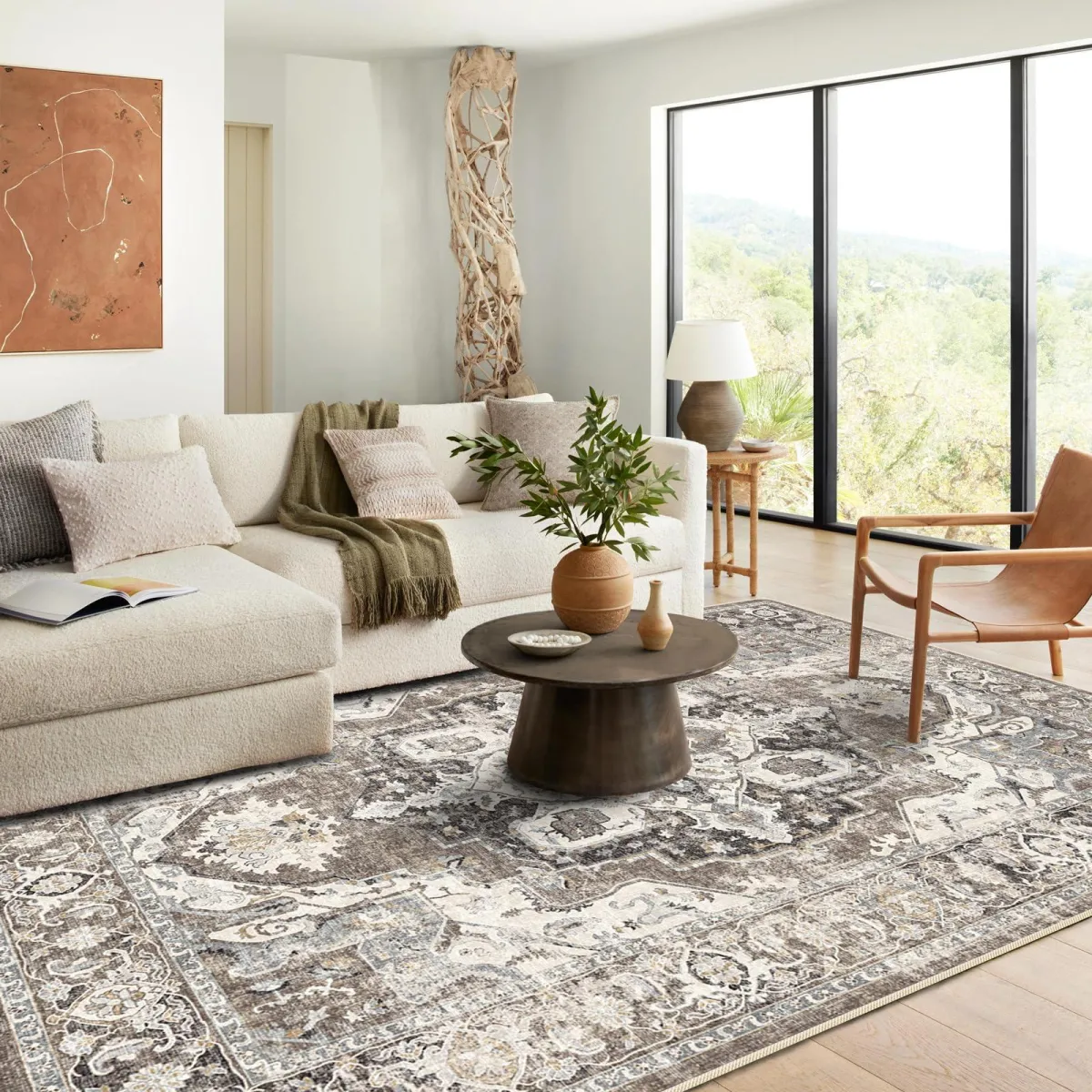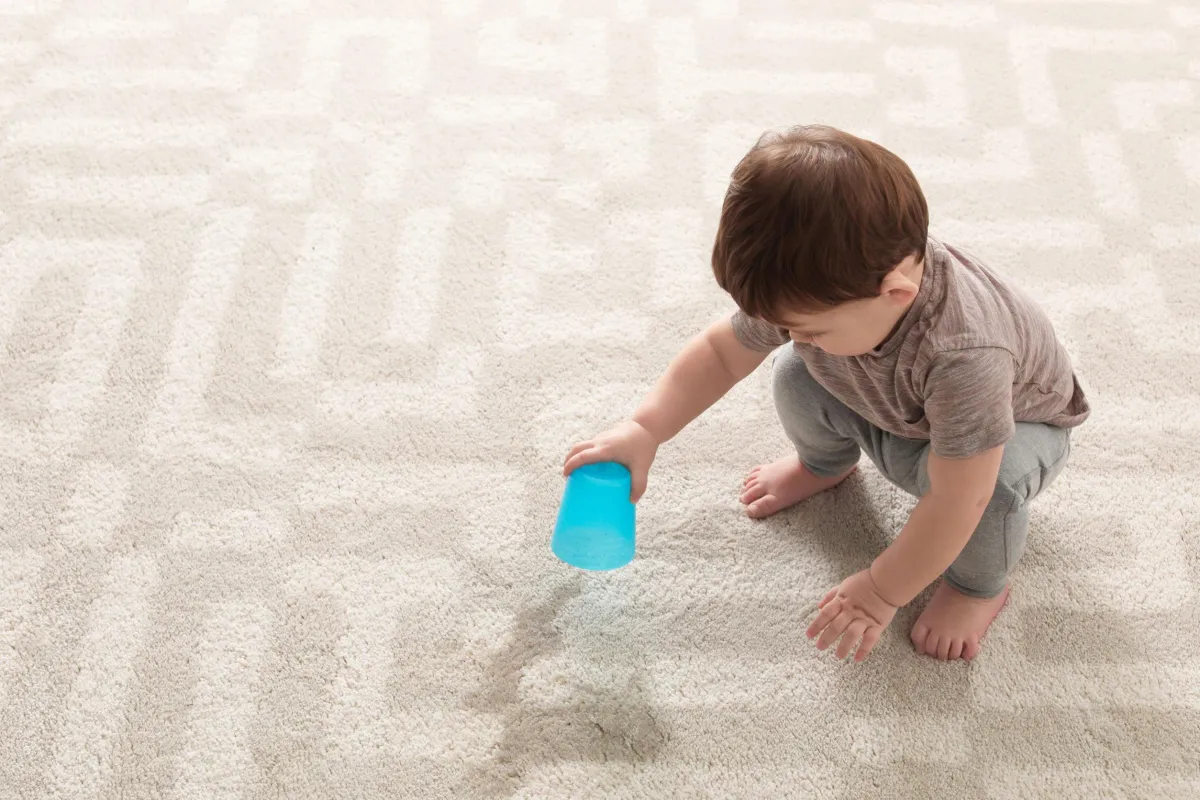SCHOCH TILE
AREA RUGS
Unlimited Creativity
Area Rugs By Schoch
Click Each Section For More Details

WELCOME HOME AND TO THE WORLD OF AREA RUGS
It is our goal to provide you with quality area rugs that offer a positive and lasting effect on your home. To help achieve our goal, we’ve created a library of area rug knowledge, style choices, buying considerations, and maintenance tips. Area rugs can transport your rooms from ordinary to extraordinary. In fact, the fastest way to change a mood or character of a room is to add an area rug. They can go on top of any kind of flooring, usually with dramatic results.
A fabulous area rug can make a unique foundation or starting point around which your entire room’s décor can be coordinated. The rug becomes your design centerpiece. Area rugs are the only flooring product that you can install, then pick up and move. Change them from season to season or as your style changes. Area rugs offer you softness, warmth, and sound absorption on hard flooring surfaces. They add another layer of design and warmth when laid on top of wall-to-wall carpeting.
The cost spectrum of area rugs is just as wide and varied as the rugs themselves. Area rugs can be inexpensive or phenomenally expensive depending on the material used, how they were made, and the degree of artistry or intricacy in their design. Area rugs are generally made of wool, silk, olefin, nylon, or cotton.
Area rugs can be an investment that becomes your family heirloom and is passed down from one generation to the next, or they can be practical and fun design elements that move around to suit your mood.

HE ART OF MAKING RUGS SPANDS TIME, GEOGRAPHY, AND CULTURES
ugs can be handmade or manufactured. To understand both methods requires knowledge and for that you’ve come to the right place. This will help you understand the difference between rug types, why some wear and last longer, and help explain the wide range of prices.
The construction of area rugs is the story of man versus machine. If area rugs are a floor covering possibility for your home, any rug you choose will be constructed by either human hands or factory machines. And while modern technology enables us to mass produce area rugs in a wide spectrum of design, color, and sizes, there are differences between machine made and handmade rugs.
With factory-made rugs, you’ll have flexibility and variety. You can find the same design in different sizes and different colors. Woven rugs are created on automated weaving looms in which multiple colors of yarn are sewn into a backing material. The rugs’ elaborate designs are created by the placement of the different colors of yarn. Handmade rugs are custom made, one-of-a-kind designs that incorporate creative uses of color.
THREE ELEMENTS TIE ANY HANDMADE RUG TOGETHER.
With handmade rugs, even if the overall same pattern is created, there will still be unique details and intricacies due to the village, city, or country of the creator. Plus, handmade rugs are often created with natural dyes that provide longevity of the colors. The three most important things to consider when purchasing a handmade area rug are weave, knot, and dyes.
There are three major techniques to making handmade area rugs: pile weave, flat weave, and hand tufted. Pile weave, or knotted weave, refers to the method of weaving used in most rugs. In this technique, the rug is woven by a creation of knots. A short piece of yarn is tied around two neighboring warp strands creating a knot on the surface. After each row of knots is created, one or more strands of weft are passed through a complete set of warp strands. Then the knots and the weft strands are beaten with a comb securing the knots in place. Every single knot is tied by hand. A rug can consist of 25-1,000 knots per square inch.
Flat weave refers to the technique of weaving where no knots are used in the weave. The weft strands are simply woven through the warp strands. These weavings are called flat weaves since no knots are used in the weaving process and the surface looks flat.
A hand-tufted rug is created without tying knots into the foundation, but rather by pushing wool or acrylic yarn through a primary backing, creating a “tuft”. Then, using a latex glue to hold the tufts in place, a rug maker will apply a secondary foundation, or “scrim”, which is covered by a third and final cloth backing to protect your floor. The final step involves shearing the tops of the looped tufts to create the pile. Hand-tufted rugs can be made faster than hand-knotted rugs, therefore they are generally less expensive than their hand-knotted counterparts.
Most handmade rugs are woven by tying knots on the warp strands. Knot density refers to the number of knots per square decimeter in a handmade rug. Thus, the higher the number of knots per square inch, the higher the quality, and thus the higher the price of the rug. The process of changing the natural color of materials in the rug is called dyeing. Rugs can be dyed by either using natural dyes or synthetic dyes. Today, mostly synthetic dyes are used for coloring weaving yarns. Natural dyes are used in places where they are easily obtainable.

THOUSANDS OF AREA RUG STYLE CHOICES MEANS THERE IS A RUG FOR EVERYONE
Your perfect rug awaits you. Styles range from Turkish, Oriental, and natural to more modern versions that are geometric, traditional, transitional, and contemporary. Patterns are abundant and can be found in florals, solids, stripes, plaids, and even holiday. From the simplest cotton throw rug to a majestic, intricately-crafted Persian rug, your choices are virtually endless.
PERSIAN: VARIETY ABOUNDS.
Persian styles are the most diverse styles worldwide. A true Persian rug is one that is hand-knotted in Iran, formally called Persia, and features a border to emphasize the main pattern. Several other narrower borders may also be part of the design and this border motif is the signature of all Persian rugs. They are considered an investment and keepsake that can be passed down through generations.
ORIENTAL: ALWAYS TRADITIONAL.
Recognized for centuries for their warmth and intricate designs, Oriental area rugs are handmade, rather than mass produced, and are known to be extremely durable and long lasting. Each one is unique and playful. The pattern changes direction without warning.
CHINESE: THE LITERAL DESIGN.
Unlike most Oriental rugs, the motifs in Chinese rugs do not unite to create one design. They stand alone. Traditional Chinese Rugs are immediately recognizable by their simple, classic motifs and unusual colors. These rugs often feature a center, circular medallion and are framed with a simple, wide border. These rugs are usually of high quality and extremely durable.
TURKOMAN: THE GUL.
Turkoman rugs are easily distinguished by their three characteristics of a dominant red background color, geometric pattern, and a unique octagonal motif known as gul. Gul is the Persian name for a flower. The layout is generally all-over and guls are repeated in rows.
CAUCASIAN: FOR THE GEOMETIC MINDED.
Caucasian rugs have very common characteristics. The patterns are very geometric. Once common characteristic is the positioning of similar shapes in different sizes next to one another. They are colorful and have a bright palette.
TIBETAN: MOUNTAINS OF COLOR.
The distinguishable characteristics of Tibetan rugs are their vivid colors, huge motifs, and relatively plain backgrounds. Tibetan rugs are known for their wonderful depth and richness achieved through subtle variation of color and texture. These rugs are woven exclusively with Nepalese wool, which is characteristically flexible, strong, lustrous, and springy. The bold and eclectic patterns and coloration, heightened by a rich texture, reveal a primitive sophistication unique to these rugs.
INDIAN: BIG ON FLORAL.
Indian designs are mainly an all-over layout with very small floral motifs. Often the same motif is repeated through the entire rug. There is not much color contrast in these rugs. Brownish-red is the dominant color.
NATIVE AMERICAN: NAVAJO FABRICS.
Native American weaving is mainly associated with Navajo wool blankets. Original styles consist of stripes and simple geometric shapes
EAST TIRKESTAN: HARD TO FIND, EASY TO LOVE.
East Turkestan rugs have always been rare, and they are only woven on a very small scale. Their pattern is mainly geometric and tends to be long and narrow. The layout can be either medallion or all-over. A very common design is the pomegranate and vase, which is a symbol of fertility.
KILIMS: ONE OF A KIND.
Kilim rigs are flatwoven textiles made by nomadic people. These textiles are used to cover doors and windows and as prayer rugs. No two hand-woven Kilim rugs are the same in color or size, which give the rugs a unique appeal.
BRAIDED: PRACTICAL AND BEAUTIFUL.
These rugs are constructed traditionally from wool but can be made from nylon, chenille, olefin, or polyester. Braided rugs can be crafted into any size or shape and are very durable, hard weaving, and easy to care for. These are rugs made from heavy strips of yarn or fabric that has been braided into thick ropes and are then sewn side-to-side in spirals, ovals, round, or oblong shapes.
FLOTAKI: THE SHAGGY RUG.
Often referred to as sheep-skin rugs, these are made from 100% hand-woven New Zealand wool. It is a shaggy-looking rug that is very inviting and cozy. Flokati are contemporary rug styles with long pile and natural colors.
SISAL: A STRONG AND VERSATILE NATURAL MATERIAL.
Sisal rug fibers come from the leaves of the Agave Sisalana plant that is grown as a renewable resource. These fibers range in color from yellow to creamy white and are spun into yarn and then woven into carpet. Although sisal by itself can be a bit tough on the feet, it can be combined with wool or nylon for a softer feel. Sisal rugs are durable, provide sound absorption, and are naturally insulating and fire resistant.
JUTE: POPULAR FOR USE THROUGHOUT THE HOME.
These rugs are woven with loop or flat construction. Jute fibers are stripped from their stalks and can be spun into yarn or rope and then woven. Jute yarns are strong and often used as warps in knotted rugs.
SEAGRASS: NATURAL BEAUTY AND STRENGTH.
A product of the paddy fields of China and India, seagrass area rugs are durable, stain resistant, and come in warm beige tones with undertones of green. Different patterns are available, making these rugs the perfect accent to any room in your home.
BAMBOO: ONE OF THE FASTEST GROWING PLANTS ON THE PLANET.
They are plentiful in supply and make strong and beautiful area rugs. Bamboo rugs are woven from natural bamboo fibers and feature natural variations in color. Bamboo rugs offer texture and style to your room’s décor in a simple and understated way.
TURKOMAN: THE GUL.
Turkoman rugs are easily distinguished by their three characteristics of a dominant red background color, geometric pattern, and a unique octagonal motif known as gul. Gul is the Persian name for a flower. The layout is generally all-over and guls are repeated in rows.
CAUCASIAN: FOR THE GEOMETIC MINDED.
Caucasian rugs have very common characteristics. The patterns are very geometric. Once common characteristic is the positioning of similar shapes in different sizes next to one another. They are colorful and have a bright palette.
TIBETAN: MOUNTAINS OF COLOR.
The distinguishable characteristics of Tibetan rugs are their vivid colors, huge motifs, and relatively plain backgrounds. Tibetan rugs are known for their wonderful depth and richness achieved through subtle variation of color and texture. These rugs are woven exclusively with Nepalese wool, which is characteristically flexible, strong, lustrous, and springy. The bold and eclectic patterns and coloration, heightened by a rich texture, reveal a primitive sophistication unique to these rugs.

FIVE STEPS TO BUYING THE IDEAL AREA RUG
There are five important elements to consider before purchasing an area rug: size, color, pattern, style, and design.
SIZE AND SHAPE
Area rugs are made in different sizes and shapes. Shapes can be rectangle, round, square, oval, octagon, or runners. Generally, choosing the right size area rug depends on the dimensions of the room you are trying to cover. If you want to cover most of the room, be sure to leave a 12-15” border of flooring exposed to set off your area rug. If you are placing an area rug under your dining room table, select a rug that is large enough so that when seated at the table, the back legs of the chairs are on the rug with enough space to push back and get up from the table.
COLOR
Color is one the most vital elements of an area rug. Select a rug with colors that visually enhance your room’s décor. The colors don’t have to match the other colors in the room perfectly. Feel free to express yourself.
PATTERN
Pattern is one of the most helpful elements in narrowing down rug selection. In the rug industry, pattern is divided into three categories: curvilinear, geometric, and pictorial. The first two refer to rugs with conventional motifs that are woven with curving lines or straight lines. The third refers to rugs that portray people or animals.
STYLE
Style can be defined as the way different motifs, colors, and patterns give character to a rug. Styles range from floral to contemporary to traditional. They can also reflect a season or a theme.
DESIGN
All rugs can be divided into three major deigns: all-over, medallion, and one-sided. All-over have motifs spread throughout the rug. Medallion designs have a large centerpiece as the focal point. One-sided designs are woven in one direction. Designs can be simple or intricate, solid, or feature patterns and borders.
CALCULATE THE TOTAL COST OF RUG OWNERSHIP.
The price tag of the rug you are buying is just one component of your cost. To ensure there are no surprises and that the rug you select fits into your budget, ask to have the total cost of your floor covering project to be calculated. Other potential expenses might be product delivery, financing, and extended warranties.

Ceramic Tile Is Dynamic
Ceramic tile’s unique character and texture adds energy, excitement, and enhancement to any room. The multitude of styles, shapes, patterns, colors, and finishes offer you a home that can range from elegant and quiet to vibrant and provocative. Ceramic creates magic and mystique. With a tradition that dates back to ancient civilizations, ceramic tile can be found in ancient structures all around the world.

Ceramic Tile Is Dynamic
Ceramic tile’s unique character and texture adds energy, excitement, and enhancement to any room. The multitude of styles, shapes, patterns, colors, and finishes offer you a home that can range from elegant and quiet to vibrant and provocative. Ceramic creates magic and mystique. With a tradition that dates back to ancient civilizations, ceramic tile can be found in ancient structures all around the world.

Ceramic Tile Is Dynamic
Ceramic tile’s unique character and texture adds energy, excitement, and enhancement to any room. The multitude of styles, shapes, patterns, colors, and finishes offer you a home that can range from elegant and quiet to vibrant and provocative. Ceramic creates magic and mystique. With a tradition that dates back to ancient civilizations, ceramic tile can be found in ancient structures all around the world.

AREA RUGS DESERVE THE SAME ATTENTION AS OTHER FLOORING PRODUCTS
While they may play a minor role in your home’s décor, they still deserve attention and care. You should vacuum or sweep your rug as you would wall-to-wall carpeting but being careful that the fringes don’t get pulled into the vacuum cleaner. Rotate your rug 180 degrees every few months. Rotation is necessary for two reasons. First, all parts of your rug should be exposed to light equally so that the colors fade evenly. Secondly, for traffic, as all parts of the rug should be exposed to an equal amount of traffic, so that the pile wears evenly.
ACCIDENTS HAPPEN.
A water spill should be dried immediately with a hairdryer set on a warm temperature. Try to dry both sides of your rug, if possible. In case of other liquid spills, apply salt or baking soda to the spot for a few minutes to absorb the liquid. Then vacuum up the salt or baking soda. After vacuuming, use a wet towel to gently wipe the stain in the direction of the nap. Be gentle and do not scrub your rug. If needed, contact a professional to help with stains.
HIRE A PROFESSIONAL.
Have your rug washed by a professional every two to five years, depending on the amount of traffic on the rug. Professionals will dust the rug with special equipment to get dirt out of the foundation before washing the rug. Then they will wash the rug by hand, using a natural soap. They will also make sure the rug is dried from the surface to the foundation before it is used again. Most handmade rug dealers and retailers offer appropriate cleaning products and services. Do not take your rug to general carpet-cleaning companies, as the techniques and chemicals used for wall-to-wall carpets may not be appropriate for handmade rugs.
PADDING IS AN IMPORTANT ELEMENT.
Consult with us about the proper padding to be placed under your rug. Padding will both stabilize and protect your rug. Good padding also makes it safer to walk on your rug and will protect its value and experience.
Age
Age classifies how old the rug is. All handmade rugs are placed within these three categories: Antique, Semi-Antique and Contemporary.
All-over
This is a rug layout that has no central or dominant design. In many cases the motifs on the rug are scattered across the rug.
Antique
A rug that is at least 6 decades old is considered Antique.
Arabesque
Intertwining vines, branches, leaves, or blossoms make up this motif. They may be woven in patterns that are curvilinear or geometric. An example of Arabesque is the Islimi motif.
Average
A rug in which minor repairs have been made, or may be needed. These repairs could involve warp strands that need attention, or the repair or replacement of several knots or fringes.
Background color
The dominating color in the rug’s background. Red, blue, beige and yellow are the most popular background colors and are expressed in many different hues and shades.
Border color
The major color of the rug’s border. Red, blue, beige, yellow and green are the most widely used in a full spectrum of hues and shades.
Braid
The interweaving of three or more stands in a diagonally overlapping pattern.
Brocading
A type of flat weaving in which the foundation of the rug is patterned by colored weft strands.
Category
The various locations where handmade rugs are created. Usually classified as Master Workshop, Workshop, Village or Nomadic.
Chrome Dyes
These are synthetic products created between the First and Second World Wars for dyeing weaving yarns. They are produced in an unlimited array of beautiful colors and hues. Chrome dyes are colorfast, they keep their bright intensity even when exposed to sunlight and washing.
Color
One of the signatures of handmade rugs. Every handmade rug is identified by its border and background colors. These colors are the result of natural or synthetic dyes.
Condition
This characteristic classifies the status of a rug from a quality standpoint. In the handmade rug industry there are 3 possible conditions: Worn, Average and Fine.
Contemporary
The classification of a handmade rug that is less than 25 years of age.
Cotton
In handmade rugs, this is the central material used to create its foundation.
Curvilinear
Patterns expressed through smooth, flowing, curving lines.
Dye
The process of changing the natural color of materials such as wool, silk and cotton. There are two kinds of dyes: Natural Dyes and Synthetic Dyes.
Fine
The handmade rug industry considers a “fine” rug to be in excellent shape without any holes, tears, stains or prior repair work.
Flat Weave
No knots are used in the flat weave technique of creating handmade rugs.
The weft strands are merely passed through the warp strands. The Kilim rug is an example of the flat weave technique.
Foundation
This is the basic structural element of a handmade rug and consists of Warps and Wefts.
Fringe
These are the warps that extend from the foundation at the rug’s end.
Their function is to hold the rug together and prevent the wefts from unraveling.
Geometric
These are handmade rug patterns utilizing straight lines.
Gul
The Persian word for flower or rose, the gul is a medallion, either octagonal or angular in shape, and is used in the creation of Turkoman rugs
Hand-knotted
Another word for a homemade rug.
Hand-Tufted
A hand-tufted rug is created without tying knots into the foundation, but rather by pushing wool or acrylic yarn through a primary backing, creating a “tuft”.
Iran
Iran was known as Persia until the 1930’s. Iran is believed to produce about three-quarters of all the handmade rugs in the world.
Kilim
The most recognized group of flat-woven rugs. See Flat Weave.
Knot
Rugs that are pile-woven or knotted are produced by knots. The two most used knots are called Asymmetrical and Symmetrical.
Kork
Sheared from the belly of a sheep, this is very fine wool.
Layout
The overall arrangement of motifs or objects woven into a rug.
Loom
The structure that holds warp strands taut for weaving and knotting. Looms can be in various configurations: vertical, horizontal, fixed or mobile.
Madder
A Southwest Asian plant displaying small yellow flowers, spiraled leaves, and a red root. Its root was, and in some places still is, a key source for red dye.
Make
A characteristic that determines where a handmade rug is actually created.
Master Workshop
These are specialty workshops typically managed by a well-known master designer/artist. His or her subordinates are skilled students directed by the master designer. Here, very unique handmade rugs are the rule.
Medallion
A typical rug layout in which a large centerpiece, called the medallion, is the design’s focal point.
Medallion-and-corner
A rug design utilizing quartered medallions in each corner of the rug, plus the full medallion in the center of the rug.
Minor border
Narrower bands, on each side of the main border, are referred to as minor borders or guard strips.
Motif
Any single form or integrated group of forms that make up part of the overall design of a homemade rug.
Nap
The direction in which the pile of the rug faces.
Natural Dyes
Natural dyes include plant dyes, animal dyes and mineral dyes. Until the late nineteenth century these were the only dyes used for coloring weaving yarns.
Nomadic Rugs
These are the products of sheepherders who mainly live in tents and migrate from the valleys to the mountain pastures in the summer. Usually, these rugs are small because they have to be completed in time to migrate.
One-sided
A rug layout in which the design is woven in one direction.
Pattern
The way lines are used to form shapes on a rug. The handmade rug industry recognizes three classes of patterns: Pictorial, Geometric and Curvilinear.
Pictorial
This is a pattern in which people and animals are the focus.
Pile
The material (fiber) used for weaving handmade rugs. Cotton, silk and wool are the primary pile materials.
Pile Weave
Pile weave, or knotted weave, is the most common technique used in the weaving of handmade rugs. In this method, the rug is woven through the creation of knots.
Runner
A rug that is long, narrow and rectangular. They are used in hallways, stairways and entrances. That’s why they are also called Corridor rugs.
Semi-antique
Rugs between 25 and 60 years old.
Silk
Is derived from the cocoon of silkworms. It’s an expensive fiber and less used as a pile material in handmade rugs than wool.
Size
The measurements of a rug. Handmade rugs are made in different sizes and shapes. Only rectangular shapes are sold in standard sizes because most handmade rugs are rectangular.
Soumak
Flat-woven rugs where no knots are used in the weave.
Style
It’s the way different motifs, colors and patterns give character to a rug.
Synthetic Dyes
Dyes made chemically beginning in the mid-nineteenth century for dyeing rug weaving yarns.
Textile
A product produced by weaving.
Village Rugs
Rugs made by villagers. There, most family members or the women of the family are weavers and work in their home. More types of rug styles are woven by villagers than by any other weaving category.
Warp
Vertical strands of fiber. They stretch from the top to the bottom of the rug and knots are tied to them.
Weave
The technique used in weaving handmade rugs. There are three classic techniques: Pile Weave, Flat Weave and Hand Tufted.
Weft
Horizontal strands of fiber. They are woven through the warps and added before and in between the rows of knots to keep the knots in place.
Wool
The coat of sheep. In handmade rugs, wool is the most used pile material.
Workshop
Where weavers work as employees and highly talented weavers can become master weavers. Workshop weavers are more seasoned and professional than those in nomadic tents or villages.
Yarn
A continuous strand of twisted threads of natural or synthetic material.
About Us
Transform Your Space with Top-Quality Craftsmanship
Contact Us
5282 Crookshank Rd, Cincinnati OH 45238
Phone (513) 922-3466
Copyright© 2025 Schoch Tile - All Rights Reserved.
